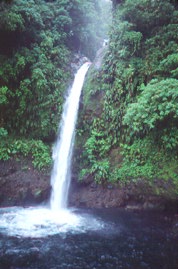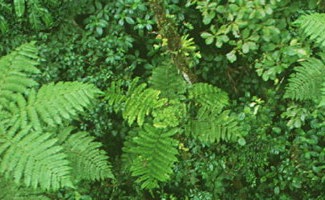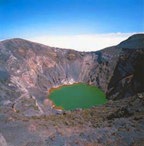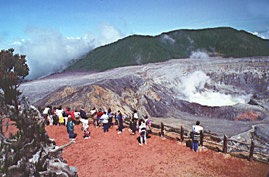 |
Costa Rica´s
National Parks
|
| Our Parks |
 Costa
Rica established the National Parks System in 1970 to prevent the
destruction of wilderness areas. Now 12 percent of the country is
protected as national parks, and a further 16 percent as Indian reserves,
biological reserves, wildlife refuges and wildlife corridors. This
means that more than a quarter of Costa Rica has been set aside for
conservation. Costa
Rica established the National Parks System in 1970 to prevent the
destruction of wilderness areas. Now 12 percent of the country is
protected as national parks, and a further 16 percent as Indian reserves,
biological reserves, wildlife refuges and wildlife corridors. This
means that more than a quarter of Costa Rica has been set aside for
conservation.
Many species that are threatened or even extinct in neighboring
countries, still thrive here. The parks envelop complex ecosystems
ranging from cloud forest to marsh land, savanna, rain forest and
coral reef, and contain extraordinary biodiversity. In most parks
it is possible to see several different habitats within the course
of a day. An international effort is underway to catalog Costa Rica's
natural assets, but at the last count, this tiny country was calculated
to have just over 200 mammals (including six species of felines:
jaguar, ocelot, margay, puma, jaguarundi and tiger cats), 857 species
of bird, 10,000 insects and over 9,000 species of higher plants,
including 1,200 orchids.
Most of the national parks are easily accessible to tourists and
ecotourism is an important factor in generating the funds needed
to continue the protection of the wilderness. Over 290,000 people
visited the parks in 1994, but choose a week day and a park outside
the Central Valley and the chances are you won't see a soul.

-
Braulio Carrillo National Park
-
Irazu Volcano National Park
-
Poas Volcano National Park
-
Guayabo National Monument
-
Juan Castro Blanco National Park
-
Carara Bilogical Reserve
-
Manuel Antonio National Park
-
Ballena National Marine Park
-
Golfito Wildlife National Refuge
-
Corcovado National Park
|
| Braulio Carrillo National Park |
| With a size of (45,899 hectares) Braulio Carrillo is rugged, mountainous
and heavily forested. This is the park you see when driving from San
Jose to Limon. In fact, it was the construction of the road in 1978
that led to the creation of the park. Conservationists felt the road
would enable loggers and developers to move in. Illegal logging is
a major problem here, along with poaching, but without the protection
of the National Park Service, the situation would be far worse. Braulio
Carrillo is dramatic and forbidding with cloud-enshrouded virgin forest
covering volcanic mountains as far as the eye can see.
Trees groan under the weight of ferns, mosses, vines and bromeliads.
This is a wet and dripping place and the massive leaves of poor
man's umbrellas (gunnera) often come in handy. Kinkajous, raccoons,
sloths and pacas live in the area along with ocelot and jaguar,
although the forest is too dense to see much in the way of wildlife.
Birds are easier to spot and include guans, trogons and quetzals.
Hikers can choose between a tough, steep or short and easy one (both
beginning on the Guapiles highway). The park headquarters are just
20 km from San Jose, past the toll booths. A trail leads from the
Sacramento entrance to the Barva Volcano. Rainy all year. Some camping
permitted. Distance from San Jose: 20 km.
|
| Irazu Volcano National Park |

(2,309 hectares) protects this active volcano, the highest in the
country at 3,432 meters. It is set in a bleak, purplish moonscape
of its own creation. Like Po s, it is virtually drive-in. It
is possible to peer right into the main crater which is filled with
green, sulfurous water. The tiger cat, coyote and cotton-tail rabbit
are among the few animals that can bear to live here and even the
vegetation is sparse, consisting primarily of stunted miconias and
black oak. By contrast, the farmland that covers the lower slopes
and surrounding area, is beautifully green and fertile. Irazu's
last eruption was on the day of President John F. Kennedy's visit
in 1963. Ash showers followed by rain left the Central Valley covered
in black soot and sludge for months. Distance from San Jose: 52
km
|
| Poas Volcano National Park |

Poas Volcano National Park (5,600 hectares) is one of Costa Rica's
most popular parks. Its two craters are the big attractions and,
like the crater at Iraz£, they are virtually drive-in. The first
crater, over 1.5kms wide, is filled with geysers and active fumaroles.
A hot sulfurous lake sits, bubbling at the bottom, 300 meters below.
The vegetation is stunted and twisted and sparse because of acid
rain and the constant emission of gasses. A second crater, Botos,
is filled with deep blue water and surrounded by damp cloud forest
vegetation. There are plenty of birds here, including the resplendent
quetzal and hummingbirds. If visiting in the rainy season, arrive
as early as possible as the crater is often hidden by cloud. The
park is occasionally closed due to increased volcanic activity.
Distance from San Jose 55 km.
|
| Guayabo National Monument |
|
Guayabo National Monument (218 hectares): Costa Rica never had
a truly great pre-Columbian civilization on the scale of the Mayans
or the Incas, but it did have a scattering of smaller tribes of
its own. Archaeological investigation at Guayabo on the southern
slopes of the Turrialba volcano has uncovered the remains of a sizable
town. The stone structures date back to around 300 A.D and include
cobbled streets, quite sophisticated aqueducts, house foundations
and bridges. Well preserved petroglyphs and monoliths tell a story
that is still to be deciphered. Guayabo is a lovely, peaceful place
to visit with plenty of birdlife, including keel-billed toucans.
Distance from San Jose 85 km.
|
| Juan Castro Blanco National
Park |
|
Juan Castro Blanco National Park (24,000 hectares) is located in
the northern lowlands, east of Ciudad Quesada. It covers the rain-forested
flanks of the Platanar Volcano, one of the lesser known volcanoes
along the country's volcanic spine. Heavy rainfall results in varied
vegetation and many rivers and springs. The transitional rain forest,
cloud forest attracts the country's finest bird, the resplendent
quetzal. Distance from San Jose: 120 kms. Accommodation available
in Ciudad Quesada.
|
| Carara Biological Reserve |
|
Carara Biological Reserve (4,700 hectares) is a transition zone
between dry tropical forest and the wetter regions to the south.
It is laced by countless rivers, the largest being the Tarcoles.
During the rainy season, the Tarcoles floods its banks, creating
a large lagoon that quickly fills with water hyacinth. Crocodiles
and caimans are easily spotted along with plenty of wading birds.
Coatimundis, peccaries, white-face capuchin, howler and spider monkeys,
and the rare-two toed sloth can all be found here along with a great
variety of plant life including fabulous heliconias. Carara is one
of the few nesting areas remaining for the scarlet macaw. Throughout
the day, the macaws can always be heard and often seen in flight,
particularly around dusk. There are two paths. One starts at the
main entrance and takes a short circular route, the other begins
2 km away and passes the lagoon.
Easily accessible for day trips from San Jose, but accommodation
also available locally.It is located 88 km west of San Jose
|
| Manuel Antonio National Park |
|
Manuel Antonio National Park (683 hectares) is Costa Rica's most
famous national park and one of its most visited. It comprises a
small, forested area, heavily populated by monkeys and raccoons,
and three exceptionally beautiful beaches. It is one of the few
remaining areas in which the squirrel monkey is found. Trails pass
through secondary forest and primary forest, dominated by bastard
cedar and balsa and mangrove swamps. The beaches are fringed with
coconut palm, as befits a tropical paradise. A tombolo makes a footbridge,
connecting the mainland to what used to be an island, Punta Catedral.
Unfortunately there is no bridge across the river that has to be
crossed to reach the park entrance and visitors arriving at high
tide will have to wade through chest high water.
Camping and accommodation are available within walking distance
of the park. Distance from San Jose: 275 kms.
|
| Ballena National Marine Park |
|
Ballena National Marine Park protects a coral reef and some particularly
rich, clear waters in an area south of Dominical on the Pacific.
Common and bottlenose dolphins can be seen from the shore and visitors
are sometimes lucky enough to see migrating humpback whales. Ballena
Island is an important roosting spot for plenty of seabirds including
frigatebirds, brown pelicans and white ibis, as are the mangroves
in the coastal sector. Boat trips and accommodation can be arranged
in Uvita and Dominical. Distance from San Jose: via Quepos 228 km
(includes stretch of bad road), via San Isidro 190 km.
|
| Golfito Wildlife National Refuge |
|
Golfito Wildlife National Refuge (1,309 hectares) is an area of
extremely verdant, wet forest, covering the low mountains directly
behind the southern Pacific port of Golfito. An interesting 400
meter cliff is presumed to mark a fault line. Thick forest contains
200 or so species of trees and shrubs including the purpleheart
so beloved of salad bowl makers, butternut, guava and black palm.
Jaguars are reputed to be present but you are more likely to spot
white-nosed coatis, agoutis and raccoons. Rainy all year. Distance
from San Jose: 340 kms
|
| Corcovado National Park |
|
Corcovado National Park (54,500 hectares) includes a huge range
of habitats from wet, mainly impenetrable rain forest to dripping,
steamy cloud forest, oak forest seashore and swamp. The park is
located on the Osa Peninsula on the southern Pacific coast and fringed
to the west by endless, wide, flat sandy beaches. The 1000 hectare
Corcovado lagoon and swamp harbors large crocodiles and many of
the park's 140 mammals. Tapir can be seen along the gravel river
banks of the R¡o Claro and R¡o Sirena and monkeys swing above every
trail. All the country's big cats live in Corcovado. Jaguars are
occasionally seen on the beach and the grassy airstrip near Sirena
and it is not uncommon to see their prints along the muddy trails.
There are over 400 species of birds including hummingbirds, trogons,
toucans and the largest population of scarlet macaws in Central
America. A night visit to the mouth of the R¡o Claro to watch the
extraordinary fishing bulldog bat in action is not to be missed.
Another Corcovado phenomenon is the presence of hammerhead sharks
in the river mouths - hikers should wait until low tide to cross
them!
Corcovado is hard to get to and even harder to hike through but
if you are fit enough, the chance to experience such splendor and
isolation shouldn't be missed. Two routes take you along the coast
north to south, or along the coast and inland (east). Visitors to
Corcovado can fly to Palmar and then take a boat along the Rio Sierpe
to the village of Drake or fly to Golfito and take a boat across
the Gulfo Dulce to Puerto Jimenez.
|
[Home] [Hotels] [Restaurants]
[Packages] [Car
Rentals] [Discount Air Tickets] [References]
Copyright 1997 Orbit Travel Network Costa Rica.
All Rights Reserved.
|


